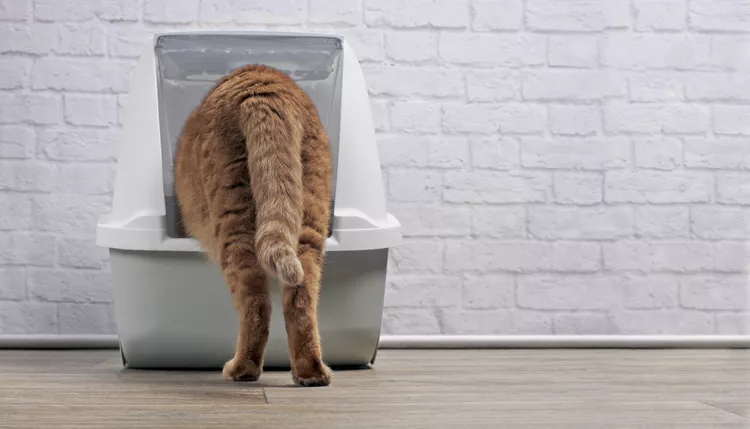Anal Sac Disease in Cats

Anal sac disease results from infected or inflamed anal glands and can be very painful for a cat. When the anal glands do not routinely release their fluid, the buildup can cause symptoms like thick secretions, foul odor, and blood in the stool. Anal sac disease can result from various factors that make a cat unable to expel its anal fluid, including soft stools, tumors, and obesity. A vet will diagnose anal sac disease using a physical examination and diagnostic tests. Sometimes, the only necessary treatment is a manual expression by a vet, but the condition can require surgery. The prognosis for treated cats is good but untreated anal sac disease can cause other health problems. You can work to prevent anal sac disease by regularly monitoring your cat's rectum.
What Is Anal Sac Disease?
Anal sac disease occurs when the anal glands, the two small balloon-like structures that release fluid on either side of a cat's rectum, become inflamed or infected. Anal sacs function like a skunk's scent glands and release territory-marking odor. Anal sacs are located just under the skin's surface and have tiny ducts that connect the sac to the rectum. When the sacs become inflamed, they don't correctly secrete, and fluid builds up and can lead to rupture. Fluid buildup from the anal sacs can thicken into a noticeable, dark, foul-smelling paste. If not expressed routinely during defecation or manually by your veterinarian, the anal sacs can foster bacteria and become engorged and very painful. Anal sac disease can result from a variety of conditions.
Symptoms of Anal Sac Disease in Cats
Symptoms of anal sac disease are very uncomfortable for your cat. If you notice an abnormality near your cat's anus, visit your vet right away.
At first, anal sac diseases will first cause minor discomfort, including anal gland fluid on surfaces, and a foul odor. As the condition worsens, your cat may cry in pain when defecating, and blood may appear in the feces. Excessive licking or biting at the rectal opening or general hind end area signify discomfort, and your cat may scoot in an effort to relieve the pain that precedes a rupture. A ruptured anal sac is relatively rare but incredibly painful, and a cat typically cries as the additional hole next to the rectum opens and bleeds.
Causes of Anal Sac Disease
If anal sacs do not express as a cat defecates, infection will occur due to bacterial buildup and inflammation. Various causes can prevent anal glands from expressing.
- Bacteria: Bacteria from feces can enter the anal glands during defecation. Once the bacteria enters the anal sac, it can multiply and infect the glands.
- Diarrhea: Soft stools do not put adequate pressure on a cat's anal sacs, inhibiting fluid expression. This can result from various conditions, including inflammatory bowel disease (IBD).
- Obesity: If a cat is obese, the ducts from the anal sacs to the rectal opening may be compressed by fatty tissue and won't allow expression during defecation.
- Tumors: A mass or tumor can block the drainage of the anal sacs. As a result, the anal sac fluid will accumulate and become infected.
- Constipation: If a cat has difficulty defecating, the anal sacs won't express with enough frequency, causing fluid buildup. Sometimes, this can be attributed to a low-fiber diet.
Diagnosing Anal Sac Disease in Cats
To diagnose anal sac disease, your veterinarian will perform a physical examination on your cat, focusing on the rectum. If a tumor is suspected, your vet will perform additional tests. Because anal sac disease shares clinical signs with parasitic infections, your vet may run a fecal flotation test to rule out other diagnoses.
Treatment & Prevention
If the anal sacs are impacted, they will need to be drained. This may be able to be done by your vet physically squeezing the sacs or may require a surgical incision. Never attempt to drain the anal sacs at home. Reparative or removal surgery is necessary if the anal sac has ruptured or abscessed. Your vet will likely prescribe antibiotics, pain medications, and a specialized diet during your cat's recovery.
The best preventative measure against anal sac disease is close monitoring of your cat's bowel movements and rectal health. Additionally, obesity contributes to developing anal sac disease, so maintaining a healthy lifestyle for your cat is essential in preventing anal sac disease. Probiotics, prebiotics, and fiber can help keep feces firm and promote natural sac expression.
Prognosis for Cats With Anal Sac Disease
The prognosis is good for cats that have been treated for anal sac disease. Infection usually doesn't recur but is possible in obese cats. If your cat isn't treated, the disease can cause secondary infection or cancer. Following surgery, your cat may suffer from incontinence, but this usually quickly resolves itself.
-
Why do cats have anal sacs?
Anal sacs function as territory markers or predator repellants. Domestic cats don't need anal sacs, therefore their removal doesn't negatively impact a cat.
-
What do anal secretions smell like?
Anal sac secretions usually smell like rotten fish, rancid cheese, or metallic. You'll likely be able to recognize the foul odor from its intensity.
-
Is anal sac disease fatal?
If treated, anal sac disease is not at all fatal, and usually doesn't recur. However, if untreated, it can lead to complications and other illness.